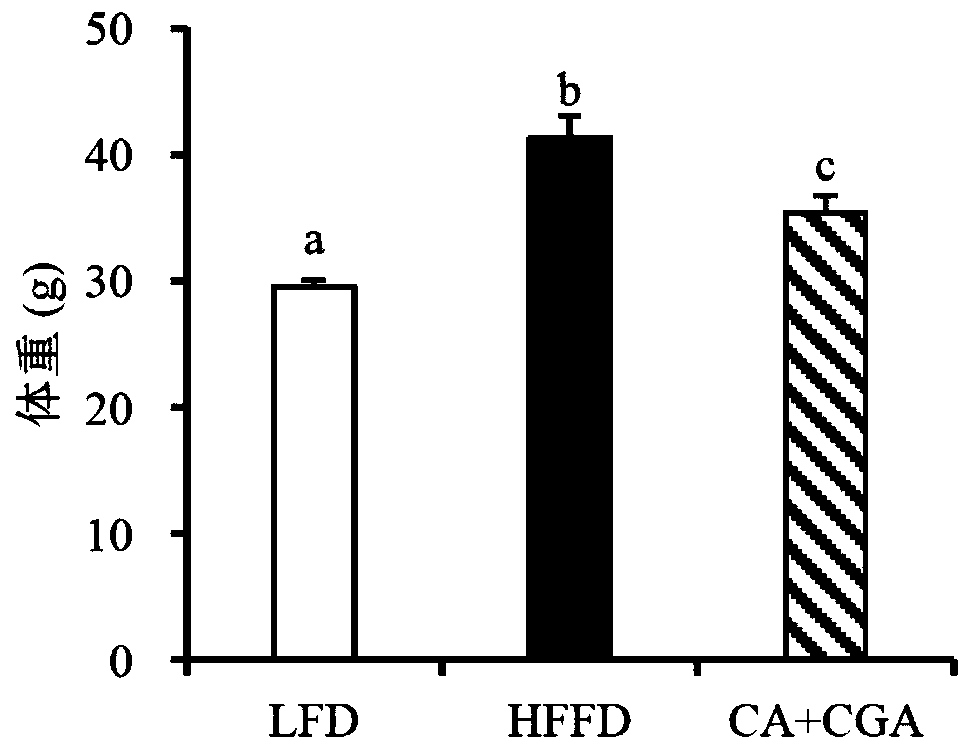Pharmaceutical composition containing p-coumaric acid and application of composition
A technology of p-coumaric acid and composition, which is applied in the direction of drug combination, medical preparations containing active ingredients, pharmaceutical formulas, etc., to achieve the effect of improving glucose tolerance and insulin resistance
- Summary
- Abstract
- Description
- Claims
- Application Information
AI Technical Summary
Problems solved by technology
Method used
Image
Examples
Embodiment 1
[0043] Example 1 High-fat and high-sugar diet-induced inhibition verification test of body obesity
[0044] Unless otherwise specified, the C57BL / 6J mice used in the following examples were purchased from Beijing Weitong Lihua Experimental Animal Technology Co., Ltd.; p-coumaric acid, chlorogenic acid and glucose were chromatographically pure and purchased from Sigma Aldrich (Shanghai) Trading Co., Ltd.; the insulin used is biosynthesized human insulin commercially obtained from formal channels.
[0045] In order to verify the anti-obesity effect of coumaric acid and chlorogenic acid, the present invention fed C57BL / 6J mice with high-fat and high-sugar food. The 4-week-old mice were randomly divided into three experimental groups according to body weight, with 10 mice in each group. The three test groups are:
[0046] Normal grain feeding group (LFD), wherein, the grain energy fed to this group is 3.2kcal / g, contains 4.5% fat, and the drinking water is pure water.
[0047] ...
Embodiment 2
[0052] Example 2 Verification Test of Body's Glucose Tolerance and Insulin Resistance Induced by High Fat and High Sugar Diet
[0053] Obesity is often accompanied by disturbances in glucose homeostasis, resulting in glucose tolerance and insulin resistance. Therefore, the present invention has carried out the following tests to the mice of each test group in the 10th week of administration in embodiment 1:
[0054] 1. Intraperitoneal glucose tolerance test (intraperitoneal glucose tolerance test, IGTT): the mouse after 11 weeks of administration in Example 1 was fasted for 16 hours, and the glucose of 1.5g / kg body weight was injected intraperitoneally after weighing, respectively Blood glucose was measured at 0min, 15min, 30min, 60min, 90min and 120min.
[0055] Such as image 3 As shown, as time goes by after glucose injection, the average blood glucose level of the mice in the HFFD group is higher than that of the mice in the LFD group, while the average blood glucose lev...
Embodiment 3
[0060] Embodiment 3 body heat production test
[0061] The mice treated for the 10th week in Example 1 were placed in room temperature (25° C.) and cold stimulation (4° C.) environments for 3 h respectively, and the body temperature of the mice was measured; the Cooled Incubator / LabMaster (TSE Company) software was used to monitor the consumption of the mice for 24 h. Oxygen.
[0062] The result is as Figure 7 As shown, CA+GCA treatment enhanced body heat production in mice in a cold environment, and was induced by Figure 8 It can be seen that compared with the mice in the HFFD group, CA+GCA treatment increased the oxygen consumption level of the mice by 23.76%, which indicated that CA+GCA treatment enhanced the energy metabolism of the mice, thereby resisting related diseases such as obesity and insulin resistance.
PUM
 Login to View More
Login to View More Abstract
Description
Claims
Application Information
 Login to View More
Login to View More - R&D
- Intellectual Property
- Life Sciences
- Materials
- Tech Scout
- Unparalleled Data Quality
- Higher Quality Content
- 60% Fewer Hallucinations
Browse by: Latest US Patents, China's latest patents, Technical Efficacy Thesaurus, Application Domain, Technology Topic, Popular Technical Reports.
© 2025 PatSnap. All rights reserved.Legal|Privacy policy|Modern Slavery Act Transparency Statement|Sitemap|About US| Contact US: help@patsnap.com



